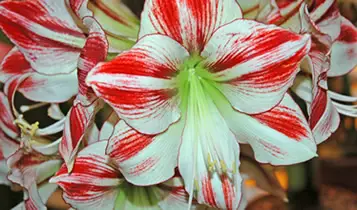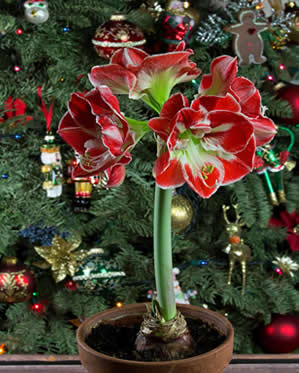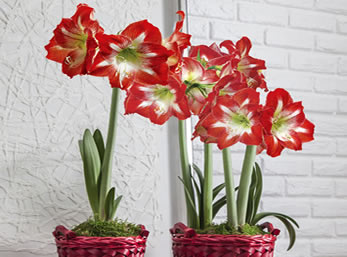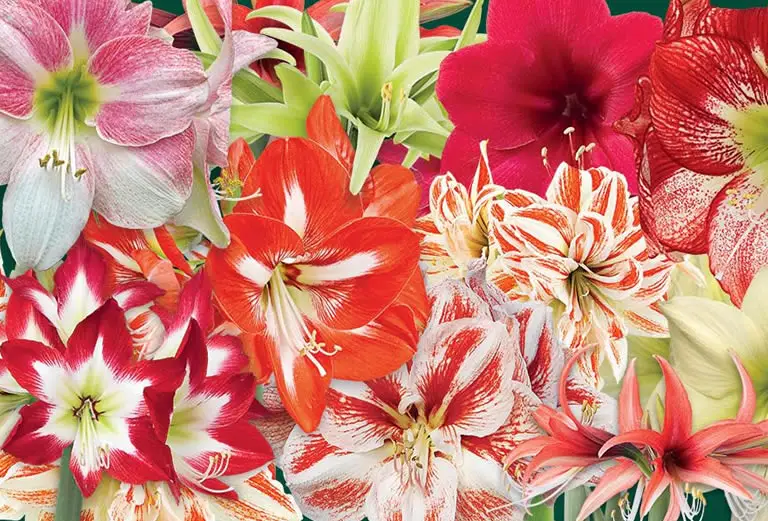Amaryllis is a succulent that comes in a variety of species with different colorful, vibrant blooms. With an 8 week grow cycle it is relatively easy to cultivate amaryllis for a Christmas bloom time. In this article I cover everything you need to know about amaryllis and its connection to Christmas as well as giving you a detailed 9 step guide for cultivating a bountiful, vibrant amaryllis Christmas bloom.
Table of Contents
AMARYLLIS CHRISTMAS BLOOMING GUIDE
In this article I will cover the following topics:
- Why amaryllis is considered a Christmas plant.
- How to cultivate amaryllis to give you a Christmas bloom.
- How to ensure you get Christmas reblooms from the same amaryllis every year.
So, without further ado let’s get started.
Not all amaryllis are really amaryllis – know what plant you have
Amaryllis is a perennial succulent which is most popular is America as a houseplant. However, amaryllis can grow outside in USDA climate zones 9 through 11 as it is a tropical and subtropical plant.
How can a plant be both tropical and subtropical you may ask?
That’s a good question. You see technically amaryllis only comes in 2 varieties, Amaryllis belladonna which is native to the south-west Cape Provinces of South Africa and Amaryllis paradisicola that is native to the west Cape Provinces of South Africa.
However, variations of the genus Amaryllidaceae are often sold as amaryllis even though they are strictly speaking not amaryllis at all. The most popular of these being Hippeastrum.
Luckily, all variants of plant species that are marketed as amaryllis have the same care needs, so you should not get too hung up on whether you have an amaryllis proper or a species of Amaryllidaceae.
Amaryllis naturally flowers once per year. As a perennial it will flower every year and, if cared for properly, will live for many decades.
Why amaryllis are a popular Christmas flower
I read on one website, and also in one offline source, that amaryllis was historically associated with Christmas largely due to the hybrid flowering plant named in honor of the Virgin Mary’s husband, and Jesus’ stepfather, St Joseph – the St. Joseph’s Staff flowering lilly.
Although technically speaking this plant is a lilly and not amaryllis, being a genus of Amaryllidaceae (Hippeastrum xjohnsonii to be precise), it is often sold as amaryllis.
So, there may be some truth to the connection between St. Joseph Staff and the use of amaryllis at Christmas but it is certainly not the main reason that we associate amaryllis with the festive season today.
There are two main reasons why amaryllis is a flowering plant that is associated with Christmas.
They are:
- Several amaryllis species have flowers that mix the colors red and white. These are the two colors that are most associated with Christmas thanks to the efforts of Coca-cola in changing Santa’s suit to match the colors of their brand.
- Amaryllis can be cultivated to bloom at Christmas.
The 5 most popular Christmas amaryllis species
There are several amaryllis species that are popular for Christmas blooms due to the color of their flowers, but there are two really stand out.
- Christmas Star amaryllis.
- Amaryllis Clown.
Most notably are the Christmas Star amaryllis and the Clown amaryllis varieties (shown below).

The Christmas star amaryllis flower has beautiful stripped petals that resemble Christmas candy cane making it a favorite bloom for the festive season.
The red petals of Clown amaryllis are mixed with small amounts of white to give a richer, deeper colored flower that resembles most Christmas decorative colors, making this an equally popular Christmas bloom.

Having said that these two species of Hippeastrum are not the only varieties of popular amaryllis used for Christmas blooms.
The next 3 most popular amaryllis Christmas blooms are:
are also very popular Christmas flowers as they offer the same Christmas colors but in different hues and mixes.
Many houseplant owner will keep 2 or more different species of amaryllis and cultivate them both to bloom for Christmas so they have a variety of different colored flowers.
You can see from the images above that these varieties of amaryllis are very complementary to traditional Christmas decorative colors. Hence, amaryllis is very popular across the US (if you live in the UK read this) as a Christmas plant. But this isn’t the only reason amaryllis is associated with Christmas.
HOW TO CULTIVATE AMARYLLIS FOR A CHRISTMAS BLOOM
Because amaryllis has a 8 week growth cycle, from new growth to bloom and because it is almost always grown in the US in as a houseplant (where temperatures are controlled and adverse weather conditions are not a factor), it is possible manipulate the bloom time of the plant. With a consistent 8 week bloom time, from new growth to flower, it is also possible to gauge the blooming time of the plant so it always blooms at Christmas.
Although amaryllis is a perennial that will rebloom every year, it only blooms once every 12 months. But the great thing about this succulent is that you can cultivate the plant to bloom in any month you desire – at least if you have a houseplant.
So, this means that cultivating your amaryllis for a Christmas bloom is not just possible, it is actually extremely easy to do.
Before I move on to showing you how to cultivate a Christmas bloom I should briefly touch on the subject of forced amaryllis reblooming.
Although it is possible to get amaryllis to rebloom within the same 12 month period, for a bi-yearly flowering, I really don’t advise you to do this. An amaryllis bulb really needs a few months of rest and should therefore always be allowed to go dormant after blooming has finished.
Forcing an amaryllis bulb to enter a new growth cycle when it should be resting is the fastest way to end up with a sickly plant that will produce inferior blooms and which will, eventually, produce no blooms at all.
Rather than exhausting the bulb, by forcing an unnatural rebloom, it is much better to simply keep an additional amaryllis plant in your home and cultivate it for a different bloom time. This means you could have one amaryllis that blooms in spring or summer and another one that blooms at Christmas.
This is much better for your houseplant than having a spring bloom and then forcing the same plant to rebloom again at Christmas.
Lecture over! 😉
How to force your amaryllis houseplant to bloom for Christmas
Now we get to the nuts and bolts of amaryllis christmas blooms. Below are the steps you need to follow to cultivate your amaryllis bulb so the plant produces beautiful, vibrant, colorful festive flowers in time for Christmas.

Because these succulents follow a very defined and definite growth cycle you can ensure your amaryllis blooms for Christmas year on year simply by regulating its growth cycle.
9 Steps to guarantee Christmas amaryllis flowers
Here are 9 steps for cultivating your amaryllis plant for a Christmas bloom:
- Begin with a new bulb. Alternatively, if you plan to use an existing plant you will need to force the bulb into dormancy first (follow these instructions for doing that).
- Use the proper process to plant the bulb in fresh soil and an adequately sized pot that allows for root growth. See this bulb planting guide for more information.
- By replanting the bulb in fresh soil (I only use Miracle-Gro potting mix for amaryllis) you will begin stimulating new growth in the bulb immediately. You must do this at the specified time before blooming is required (as I detail below). This is usually 8 weeks before you want to see open flowers on the plant, but not always.
- I have already outlined that the completed growth cycle of a mature amaryllis bulb from new growth to bloom is between 6 – 12 weeks, with the average being 8 weeks. But, because amaryllis can bloom at any time between the 6 week to 12 week stage of its growth cycle, you may find that your specific plant blooms outside of the average 8 week time frame.
- So, until you know the specific bloom point of your own plant I would suggest planting 2 or more amaryllis bulbs about two weeks apart. For a Christmas bloom this would mean planting one in late September and one in early October.
- Amaryllis flowers will last for up to 8 weeks on the stem and up to 4 weeks in a vase. With an amaryllis plant that has an 8 week bloom time, planting the bulb in mid October means you are aiming for an early to mid December bloom. As the flowers will last for 8 weeks you are thus ensured Christmas flowers. But, because your plant may not have a 8 week bloom time (if you have a new bulb you don’t know what its bloom time is) you should plant the bulb in September, so that you are covering your bases as I explain below.
- As you want to guarantee a Christmas bloom, if you only have one amaryllis plant, I suggest you plant the bulb and activate new growth in mid to late Sept, about 12 weeks before Christmas. I advise this for several reasons:
- If the amaryllis is an extremely late bloomer you will still see flowers for Christmas as you planted it 12 weeks prior.
- If the amaryllis ends up being an extremely early bloomer, and flowers after 6 weeks, you should still have some blooms left come Christmas week.
- If it blooms after 8 weeks, which is the average, the plant will start to bloom in November and you will have a vibrant flowers at Christmas.
- If the amaryllis blooms anytime between weeks 9 and 11 then you will still have flowers for Christmas.
- As I already stated, if you want to guarantee a Christmas amaryllis bloom you should plant another amaryllis bulb about 10 – 9 weeks before Christmas, in early October. This way you are almost guaranteed to have a Christmas bloom and may end up with 2 blooming plants.
- After the first year you should understand the growth cycle of your specific plant and know how long it takes it to bloom. Then if you want to change its bloom time so it is in full bloom exactly during the Christmas period you can force dormancy, and then force new growth at the specified time prior to the desire bloom time, by following the instructions outlined on this website and link to in this article already.
If you plan to cut some of the flowers off the stem, for vase use, then you will want to read my article on using cut amaryllis flowers. This article contains information for the proper removal of flowers from the stem and also key insights into how to lengthen the lift-span of amaryllis flowers placed in a vase.
DON’T THROW YOUR AMARYLLIS BULB AWAY AFTER BLOOMING
So once you have cultivated an amaryllis plant to bloom for Christmas, do you only get one year of flowers or will the plant bloom again?
Once cultivated for a Christmas bloom amaryllis will continue to rebloom for Christmas every year. Just be sure you allow the bulb to go dormant and rest after blooming has finished. Then follow the correct care routine and you will continue to get Christmas blooms for decades.
Be sure to read my extensive amaryllis watering guide as this is one of the most key fundamental care requirements that many amaryllis owners get wrong.
If you want more tips for forcing an amaryllis to bloom at christmas check out our accompanying article 5 Tricks To Stunning Christmas Cactus Blooms.

